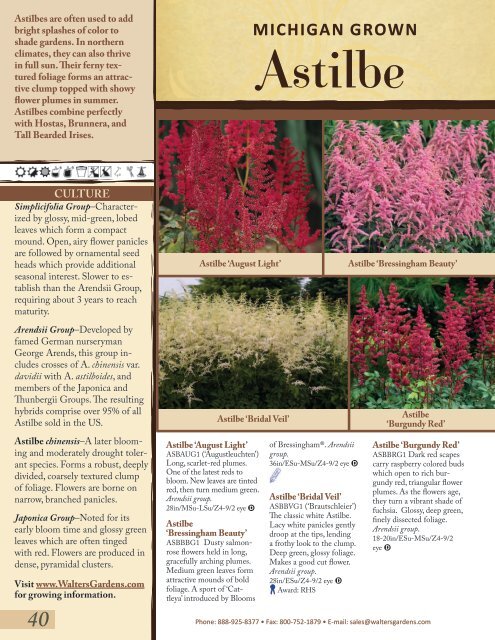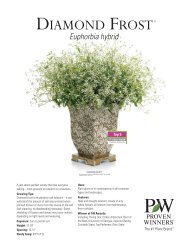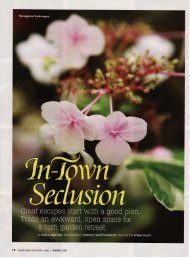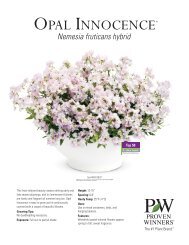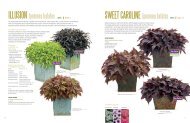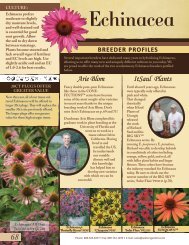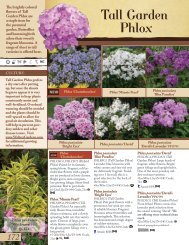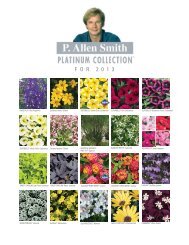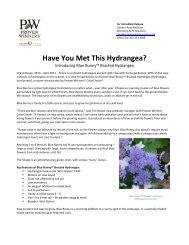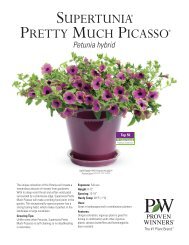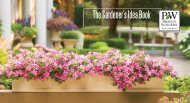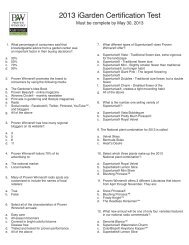Create successful ePaper yourself
Turn your PDF publications into a flip-book with our unique Google optimized e-Paper software.
Astilbes are often used to add<br />
bright splashes of color to<br />
shade gardens. In northern<br />
climates, they can also thrive<br />
in full sun. Their ferny textured<br />
foliage forms an attractive<br />
clump topped with showy<br />
flower plumes in summer.<br />
Astilbes combine perfectly<br />
with Hostas, Brunnera, and<br />
Tall Bearded Irises.<br />
MICHIGAN GROWN<br />
Astilbe<br />
CULTURE<br />
Simplicifolia Group–Characterized<br />
by glossy, mid-green, lobed<br />
leaves which form a compact<br />
mound. Open, airy flower panicles<br />
are followed by ornamental seed<br />
heads which provide additional<br />
seasonal interest. Slower to establish<br />
than the Arendsii Group,<br />
requiring about 3 years to reach<br />
maturity.<br />
Astilbe ‘August Light’<br />
Astilbe ‘Bressingham Beauty’<br />
Arendsii Group–Developed by<br />
famed German nurseryman<br />
George Arends, this group includes<br />
crosses of A. chinensis var.<br />
davidii with A. astilboides, and<br />
members of the Japonica and<br />
Thunbergii Groups. The resulting<br />
hybrids comprise over 95% of all<br />
Astilbe sold in the US.<br />
Astilbe chinensis–A later blooming<br />
and moderately drought tolerant<br />
species. Forms a robust, deeply<br />
divided, coarsely textured clump<br />
of foliage. Flowers are borne on<br />
narrow, branched panicles.<br />
Japonica Group–Noted for its<br />
early bloom time and glossy green<br />
leaves which are often tinged<br />
with red. Flowers are produced in<br />
dense, pyramidal clusters.<br />
Visit www.WaltersGardens.com<br />
for growing information.<br />
Astilbe ‘Bridal Veil’<br />
Astilbe ‘August Light’<br />
ASBAUG1 (‘Augustleuchten’)<br />
Long, scarlet-red plumes.<br />
One of the latest reds to<br />
bloom. New leaves are tinted<br />
red, then turn medium green.<br />
Arendsii group.<br />
28in/MSu-LSu/Z4-9/2 eye D<br />
Astilbe<br />
‘Bressingham Beauty’<br />
ASBBBG1 Dusty salmonrose<br />
flowers held in long,<br />
gracefully arching plumes.<br />
Medium green leaves form<br />
attractive mounds of bold<br />
foliage. A sport of ‘Cattleya’<br />
introduced by Blooms<br />
of Bressingham®. Arendsii<br />
group.<br />
36in/ESu-MSu/Z4-9/2 eye D<br />
Astilbe ‘Bridal Veil’<br />
ASBBVG1 (‘Brautschleier’)<br />
The classic white Astilbe.<br />
Lacy white panicles gently<br />
droop at the tips, lending<br />
a frothy look to the clump.<br />
Deep green, glossy foliage.<br />
Makes a good cut flower.<br />
Arendsii group.<br />
28in/ESu/Z4-9/2 eye D<br />
Award: RHS<br />
Astilbe<br />
‘Burgundy Red’<br />
Astilbe ‘Burgundy Red’<br />
ASBBRG1 Dark red scapes<br />
carry raspberry colored buds<br />
which open to rich burgundy<br />
red, triangular flower<br />
plumes. As the flowers age,<br />
they turn a vibrant shade of<br />
fuchsia. Glossy, deep green,<br />
finely dissected foliage.<br />
Arendsii group.<br />
18-20in/ESu-MSu/Z4-9/2<br />
eye D<br />
40 Phone: 888-925-8377 • Fax: 800-752-1879 • E-mail: sales@waltersgardens.com


